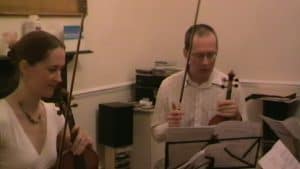From Beer to Bazzini….String Quartet Rarities
From Beer to Bazzini….String Quartet Rarities – On Friday we (Manor House String Quartet) got together in a sunny conservatory at Louise’s house to¬†play through some lesser known works for string quartet, with a view to finding pieces for forthcoming recitals and exploring some neglected works for string quartet. I had picked at random a selection of string quartets from the shelves and we decided to¬†spend the morning looking at a well known work by Schubert – his Quartettsatz in C minor (D703). We spent the first couple of hours rehearsing through this celebrated piece – trying to maintain the vitality of the rhythmic pulse throughout. As Schubert’s tempo marking at the beginning states ‘Allegro Assai’, we felt the opening figure needed to be full of an almost explosive energy. It’s a work which contrasts the most genial elements of Schubert’s Viennese qualities against the most sudden outbursts of temper (which may have their root in his medical condition at the time). In bar eleven, we savoured the extraordinary chord which was in essence a G major chord with an A flat placed near the top of the spread – which following a D flat major chord gives a feeling of discomfort and yet radiance at the same time. We tried to make the accompanying triplets lilting, but also to echo the opening.
After a lengthy lunch break in the early autumn sunshine, we went for a lucky dip into less established waters. First out of the pile was a quartet in G by Anton Beer-Walbrunn Op. 14. Beer-Walbrunn taught at the Munich academy and his pupils included Furtwangler and Alfred Einstein the musicologist. The first movement began with a stormy first subject in a very four-square style – the contrasts in mood and dynamic were very obvious and it’s fair to say that it was melodically inventive but felt as if the gear changes were a bit clunky! The second subject in this string quartet was a gentle march-type figure in B major and it wasn’t long before that first subject made another appearance with many stormy interjections. The slow movement (after initial G minor introduction) had a theme reminiscent of Schuberts’ Rosamunde. It may have been based on a German folk tune as seemingly the first violinist has some accompanying words to sing whilst playing – “Es Waren Zwei Kunigs Kinder…..” – I did attempt to sing this whilst playing as it was obviously a big hit in it’s day, but I think my singing may have put the other three players off so perhaps this is not one¬†to attempt in a public recital – or even a private one! The third movement was a heavy affair that drove forward relentlessly with lots of punctuated accents, leading straight into a slightly lighter last movement in 6/8 – although this had some lyrical moments, it was all building up to one of the biggest climaxes in chamber music history! Beer Walbrunn obviously wasn’t one to hold back and a series of climactic explosions ensued to round off an interesting piece of music.
From a thoroughly German work of the late 19th century, we now had an interesting contrast to a characteristically Italian approach courtesy of Antonio Bazzini. This is a late work from the violin virtuoso who Рas a professor of composition at the Milan Conservatory taught Mascagni and Puccini amongst others. This is a wonderful piece of string quartet writing and we all agreed it was in the top bracket of works that we have so far explored. The Allegro apassionata first movement had a very strong first subject which was clearly separated from the second subject by a pause as if changing from one scene to another in an opera. In fact, the feeling of passing from one scene of an opera to another was a characteristic of the work as a whole and one could perceive the germ of Puccini hidden in this fascinating work. The slow movement had a heartfelt theme of great purity (definately a pastoral scene including shepherds!) which had a sureness of footing throughout. The ensuing Gavotte (Intermezzo) was a scene of chattering villagers whose good natured gossiping eventually petered out in mid flow. . .The work concluded with an exciting Quasi Presto movement of great dramatic tension. It was a classic a Saltarello with a great deal of dramatic tension.So an interesting comparison between an objective German work with little descriptive narrative to an Italian work of operatic scene changes that engaged the musical imagination.
The final work proved to be a revisiting of the Quartet in G (Op 70 No 2) by Ferdinand Ries. His name is inextricably linked to Beethoven’s, being a pupil, copyist, secretary and long term friend of the great master. His father, Franz Anton had been a teacher of Beethoven in his formative years and Ferdinand was also a native of Bonn. His Quartet in G is a work abundant in strong themes with a good natured feeling throughout that leaves one feeling happier afterwards! The D minor slow movement is reminiscent of the slow movement of a Beethoven symphony and the Allegro Vivace Scherzo also has the sweep (and occasionally the storminess) of a symphonic work. Perhaps this is what Beethoven meant when he said of Ries “he imitates me too much.” The last movement is a jaunt where the opening motif interjects at various points in the bar. The whole work is masterfully executed with a picture of a well intentioned and highly talented protege emerging from its notes!
Overall another very enjoyable day of sight reading and of the pieces we played, we’re confident that both the Ries and Bazzini will make their way into string quartet recitals very soon.

